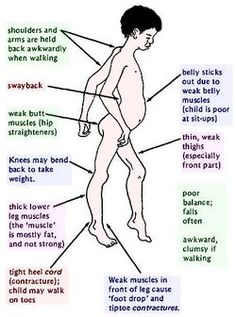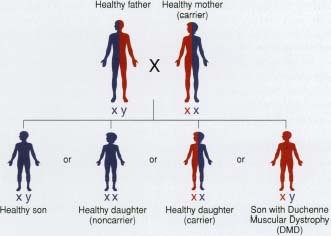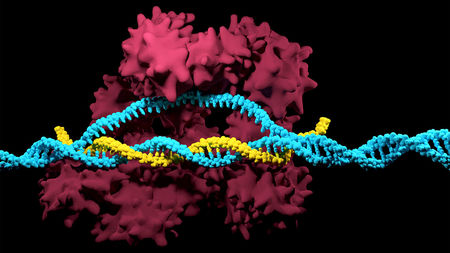These next three days are celebrated as the Labour Day weekend here in the US and is also considered the unofficial end of summer. Back when I was growing up it was also the time of the Jerry Lewis telethon to benefit the fight against the disease Muscular Dystrophy (MD), a disorder that causes an almost total loss of strength and control of the muscles and is the leading genetic cause of death in children.

Starting in 1966 and continuing until 2010 Jerry hosted the annual charity event which featured other celebrities and entertainment and which managed to raise $2.45 billion dollars for the study and treatment of MD. Despite the success of the telethon, and the large amount of money raised however MD has proven to be an intractable illness with little progress being made toward a treatment.
For those who aren’t familiar with MD it is a genetic disorder that prevents the production in the cells of the muscles of a shock absorbing protein called dystrophin. The lack of dystrophin causes the muscle cells to weaken and degenerate leading to a general failure of the bodies muscles. The first symptoms usually appear before a child is one year old.

Since MD is a genetic disorder it is not contagious but rather must be inherited from both parents, each of whom must carry a single recessive MD gene. Having a single MD gene does not cause the disease but by looking at the image below you can see how a man and woman, each of whom have one MD gene on their chromosome pair, can pass it on to their children.

Since a child gets one gene from each parent 25% get clean chromosomes from both parents, the child on the left. This child will not develop MD nor can it pass the mutated gene to its children. 50% of the offspring will get an MD gene from one parent but not the other; these are the two children in the middle. These children will not develop MD but carry the gene and can pass it on to their children just as they received it from their parents. Only the child on the right, the 25% who receive the MD gene from both parents, will actually develop the disease.
There has recently been some progress that offers a glimmer of hope in the fight against MD. The research was conducted on a family of dogs, King Charles Spaniels to be exact, who were found about ten years ago to also suffer from MD. The research used the new science of gene editing and in particular the gene cutting tool CRISPR that I discussed at some length in my post of 5Aug2018.
To put it simply CRISPR uses a virus, yes a virus to cut a section of DNA out of a chromosome with a cell and replace it with a different DNA section. The work was led by Eric Olsen at the University of Texas Southwestern Medical Center and consisted of using CRISPR to replace the mutated DNA in four one-month old male dogs.

Gene editing and CRISPR have been used before to treat other genetic disorders but MD was considered a long shot because the gene that manufactures dystrophin is the largest in the human genome and a large number of different mutations can lead to the disease. Still Dr. Olsen and his team injected the four dogs with millions of CRISPR viruses that were programmed to find and replace the mutated dystrophin gene.
The results were better than the researchers had expected. According to Dr. Olsen the dogs ‘…showed obvious signs of behavioral improvement…running, jumping…it was quite dramatic.”
Now this is only a test on four dogs, much more research will have to be carried out before any testing is conducted on humans. Still this is one more case where gene editing, and CRISPR in particular are giving us tools to fight diseases against which we once had no hope.
Which brings us to the ethical question. Changing the genes of a one-month old infant, dog or human, is playing god if anything is. And the technology that can ‘repair’ a child with MD can also create a ‘designer baby’ if that’s what we want.
As I said in my post of a little over a year ago my opinion is that we should move forward with gene editing but slowly, maintaining ethical controls on the research. I also that it is very important that we have a full-scale public debate now about how we as a society will regulate and control gene editing.
I’ve now told you my opinion, what’s yours?

Helpful info. Lucky me I found your website accidentally, and I am stunned why this accident didn’t happened
in advance! I bookmarked it.
Thanks for the comment and come back soon!
Bob L
My son started with molluscum after contact with his
cousin (who had it and we didn’t know until it was too
late). At first it was mild and then what seemed like
overnight, it started to spread and the spots became
larger and more painful. I was desperate to find
something to help. We were told to let them run their
course, but that wasn’t going to work for me. I
researched and tried several home remedies to no avail. a friend introduce me to this doctor called Dr santyjatto, he gave me herbal medicine for my son right now as I am shearing these testimony my son is perfectly okay. you can also reach him drjattosolutionhome @ hotmail. com or whatsapp +2348145243120
he told me he can cure all types of sickness like.
Muscular dystrophy
HIV
plantar wart
ALS
low sperm count
herpes
zika virus
hepatitis
penis enlargement
HPV
diabetes
cancer
and many more……
Thanks for the comment.
Bob L
I simply could not go away your web site before suggesting that I extremely loved the standard information a person supply to your guests?
Is going to be back continuously in order to investigate cross-check new posts
Thanks for the comment and come back soon!
Bob L
My brother suggested I might like this blog. He was totally right.
This post actually made my day. You cann’t imagine
simply how much time I had spent for this info! Thanks!
Thanks for the comment and come back soon!
Bob L
Truly no matter if someone doesn’t understand then its up to other viewers that they will
help, so here it takes place.
Thanks for the comment and come back soon!
Bob L
Good post. I learn something new and challenging on websites I stumbleupon every day. It will always be helpful to read through content from other writers and use a little something from other websites. |
Thanks for the comment and I hope you come back soon!
Bob L
Good post. I learn something new and challenging on websites I stumbleupon every day.
It is difficult to understand the exact content.
Glad you found your way here. I hope that you’ll come back soon!
Bob L
Major thanks for this useful article. Really looking forward to read more from you.
Thanks for the comment and since you like my blog so much why don’t you tell all of your friends?
Bob L